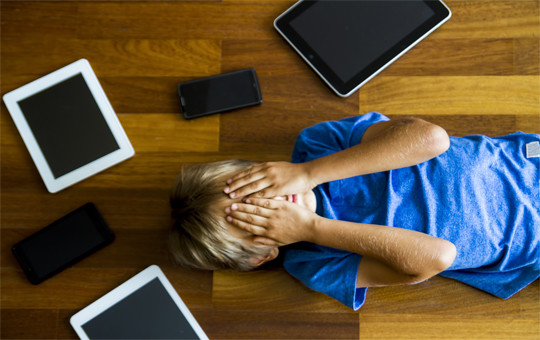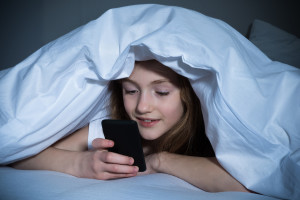Scientists are warning parents about the dangers associated with too much cell phone use. Children holding mobile phones too close to their face are at increased risk of becoming cross-eyed with the condition affecting children who use phones four to eight hours per day. While smartphones may seem like an easy way to keep young children entertained, doctors and researchers say that there are ways to utilize smartphones without increasing your child’s risk of eye damage.
The time children spend on tablets, phones, and computers can seriously strain their eyes, but it’s also hard on their backs and necks. It seems like children know how to operate tablets, smartphones, and computers almost from birth. But those mesmerizing screens expose them to a number of long-term health threats.
A study performed at Chonnam National University Hospital suggests that children between the ages of 7 and 16 who spend four to eight hours each day on a smartphone device were most likely to become cross-eyed. The reason for the temporary eye change is believed to result from the fact that the average child held the smartphone just eight to 12 inches from their face. This, according to the study researchers, causes the eyes to focus inward, resulting in the child’s eyes to temporarily cross.
Too much screen time can result in digital eyestrain, which can include burning, itchy, or tired eyes. Headaches, fatigue, blurred or double vision, loss of focus, and head and neck pain are other threats for children using screens too often and too long.
Fortunately for the children, it was revealed that doctors were able to reverse the side-effects of the cell phone usage by discontinuing the use of smartphones for two months. Though the eye problems are reversible, doctors and researchers note that they are also preventable. In order to prevent temporary convergent strabismus in a child’s eyes, it is suggested that cell phone use is limited to 30-minute intervals followed by a break for the eyes. Additionally, children should be encouraged to hold smartphones further from the face, preventing the eyes from needing to turn inward to focus. The light from the phone can also interrupt sleep patterns and circadian rhythms when children view screens close to bedtime. Make sure you don’t allow any devices in the bedroom or during bedtime.
While vision problems are a concern with cell phone usage in childhood, preventing kids from gadget addiction is also an increasing concern among parents. In Russia, it was revealed that government officials have advised that anyone under the age of 18 should not use a cell phone. France has also taken steps to decrease cell phone usage in children by making it illegal for cell phone companies to market their products to children. Meanwhile, the United Kingdom has voiced concerns about cell phone use in children noting there isn’t enough research to call it “safe.”
Research has also suggested that cell phone use in schools or during exam time leads to lower academic grades by causing distractions in the learning environment. With concerns surrounding vision problems, a potential for addiction, and trouble learning, managing child mobile screen time has become one of the biggest concern for the parents.
Get Parental Control apps for android and iOS to manage your child’s device. Nischint– UNICEF referred India’s only parental control app helps parents to manage screen time, schedule apps, monitor social media etc












